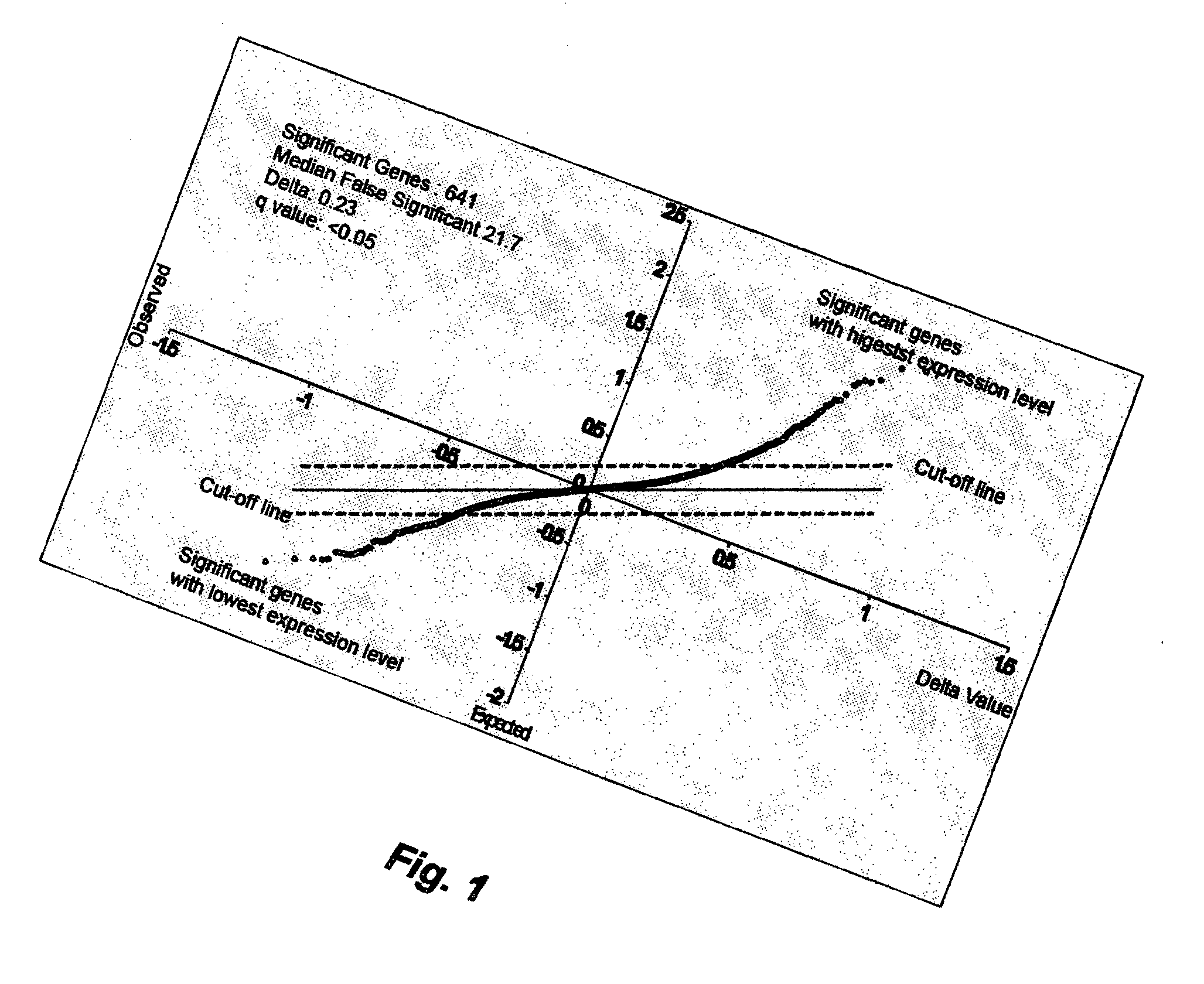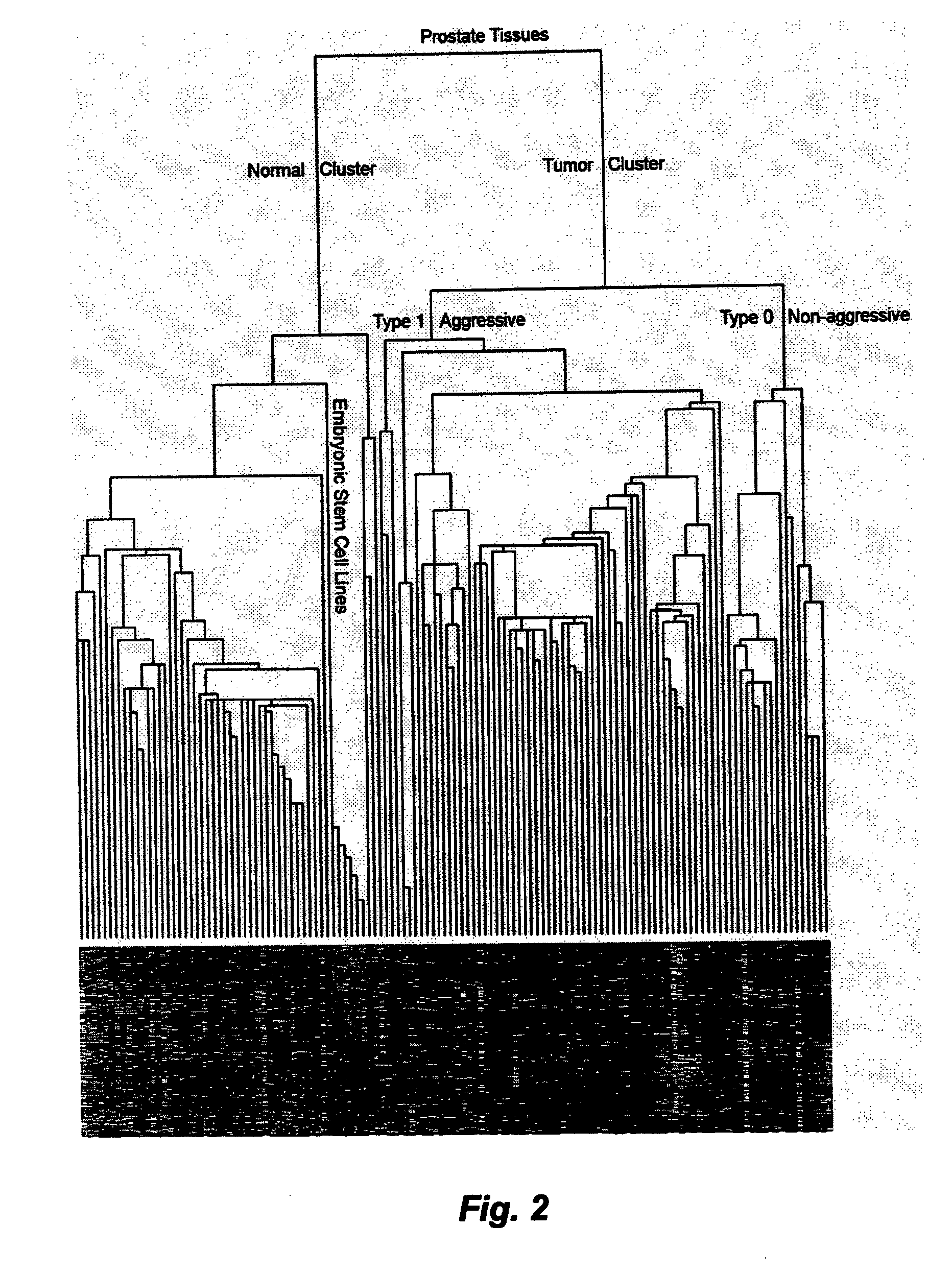Embryonic stem cell markers for cancer diagnosis and prognosis
a technology of embryonic stem cells and gene markers, applied in the field of embryonic stem cell gene markers for use in diagnosis and prognosis of cancer, can solve the problems of prostate cancer, dna changes must be detected, and the robustness and high resolution of bioinformatic analyses based on published or unpublished high throughput proteomic data, etc., to achieve high throughput, accurate measurement, and simple
- Summary
- Abstract
- Description
- Claims
- Application Information
AI Technical Summary
Benefits of technology
Problems solved by technology
Method used
Image
Examples
example 1
[0067]Data Retrieval. The method of the invention is based on published gene data such as the data sets published and deposited in the Stanford Microarray Database (SMD) (http: / / genome-www5.stanford.edu / ). All array experiments used the same two-dye cDNA array platform with a common RNA reference, which enables reliable combination of or comparison with data from different experiments. These datasets include genome-wide expression data for embryonic stem cells (60), normal tissues from most of the human organs (61), and tumors from the prostate (62), breast, lung (63), stomach (64), liver (65), blood (66), brain (67), kidney (68), soft tissue (69), ovary (70; 71) and pancreas (72). In total about 1000 arrays were included in the analysis. Each array (tissue) in these datasets is denoted with corresponding basic clinical and pathological information such as histopathological type, tumor grade, clinical stage, and even survival data in a significant fraction of tumor cases.
[0068]Gene ...
example 2
[0071]Identification of ES predictor genes. After centering a data set containing ES cells and normal tissues from most human organs, the ES data set was separated from the normal tissue data set. A one-class SAM (significant analysis of microarrays) was carried out using the centered ES dataset, by which all genes were ranked according to their expression levels in the ES cells (73). Using a q value equal to or less than 0.05 as cut-off, top 328 genes with highest level and top 313 genes with lowest level of expression in the ES cells were identified (Table 1). These 641 ES genes are named ES tumor predictor genes (ESTP genes). Previous studies used a small number of sample matrices to normalize the expression data of ES cells (60; 74); this may lead to erroneous identification of ESTP genes. In this invention, the expression data of ES genes from ES cells were centered by a matrix of over 100 normal tissues from most human organs (62). This greatly reduced erroneous identification...
example 3
[0072]Prediction of clinical and pathological tumor types. After centering each combined data set, a sub-dataset containing only the 641 ESTP genes was isolated from the original dataset. A simple hierarchical clustering was carried out based on this sub-dataset using genes with 70% qualified data in all samples (78). The sample grouping was directly correlated with the clinical and pathological information of each individual tissue sample. Prediction examples for a number of tumor types are given below. Prediction in other datasets is carried out in essentially the same manner.
[0073]In the one class SAM analysis, numbers of genes selected is in correlation with q value. There were 201 genes selected when q value at 0.01, 641 genes selected when q value at 0.05, and 1368 genes selected when q value at 0.1. In other words, an increased q value would result in increased number of selected genes as well as increased number of genes that would not be associated with the transcriptional ...
PUM
| Property | Measurement | Unit |
|---|---|---|
| stable | aaaaa | aaaaa |
| predictive power | aaaaa | aaaaa |
| prognostic power | aaaaa | aaaaa |
Abstract
Description
Claims
Application Information
 Login to View More
Login to View More - R&D
- Intellectual Property
- Life Sciences
- Materials
- Tech Scout
- Unparalleled Data Quality
- Higher Quality Content
- 60% Fewer Hallucinations
Browse by: Latest US Patents, China's latest patents, Technical Efficacy Thesaurus, Application Domain, Technology Topic, Popular Technical Reports.
© 2025 PatSnap. All rights reserved.Legal|Privacy policy|Modern Slavery Act Transparency Statement|Sitemap|About US| Contact US: help@patsnap.com



